I don’t want to be an ass in saying this comment, but really, I wonder how trains function in the United States. Commuter trains and subways, like the ones in New York, New Jersey, Pennsylvania, Chicago, and other places across the country make sense to me. They are practical, and they don’t take too long. By the time I was twenty, I had been to the city a million times, all by train. We never drove. Driving took probably around the same time as the train, and you didn’t have to worry about parking, and tolls, and traffic. Taking the train is not too expensive, as well. It just makes sense. I can count the number of times I have gone to the city by car on one hand. And the first time was when I was twenty.
But how does Amtrak work? I’ve only been on Amtrak twice, going to Florida and back with my grandmother that has a minor phobia of planes. I’ve thought of taking the Lake Shore Limited to Chicago, but that is only because I like trains, and I think it would be cool to ride what was once known as “The Water Level Route.” But other than having a phobia of planes, and being a railfan, why would I want to take Amtrak? Searching up prices, I can get a round trip flight to Orlando for July 4th for $193. That ride takes two and a half hours. Or, with Amtrak, I could ride for twenty-two hours, and pay a whopping $423. Why would anyone want to pay more than double for a trip that takes more than seven times as long? In Japan I took the bullet train to Kyoto, which in terms of time and price is very close to flying. Close enough to compete, anyways. But then that just goes back to the usual argument that the US wanted their Interstate System, while other countries, especially Japan, concentrated on rail.
That sort of demonstrates my mind-set when I think about trains. There are some times when I read about their history, that I am completely and utterly baffled by how important they once were. Rail was the way that products and people were transported. And during World War II, trains were an integral part of the war effort. The New York Central operated personnel trains, mail trains, equipment freight, and even hospital trains. An average of two million troops per month were transported over the NY Central system during WW2. I always love looking at old advertisements, so today I have a collection of old New York Central magazine advertisements from the war years. Each advertisement depicts a different scene or use for the wartime trains: from riding the 20th Century Limited, to troop trains, to the fully equipped surgery suite on an army hospital train.
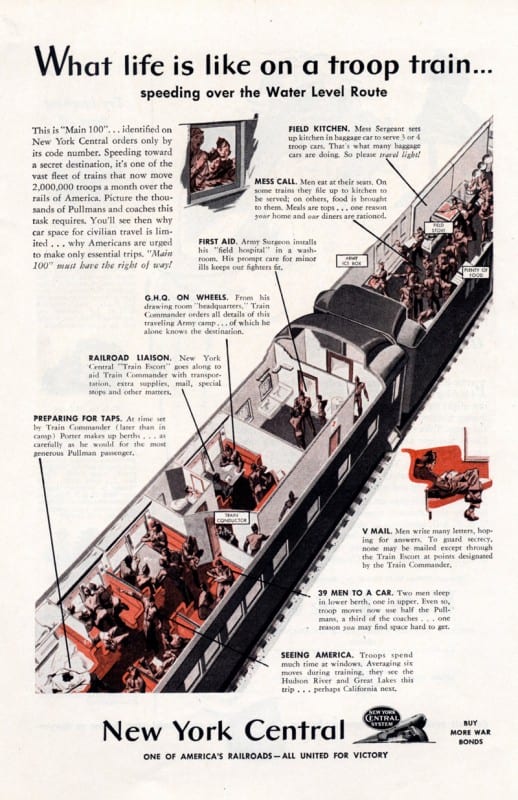
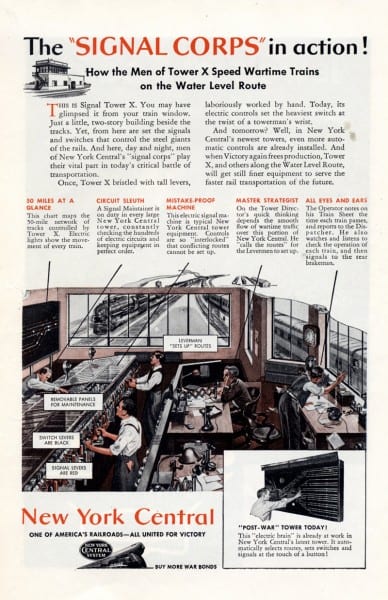
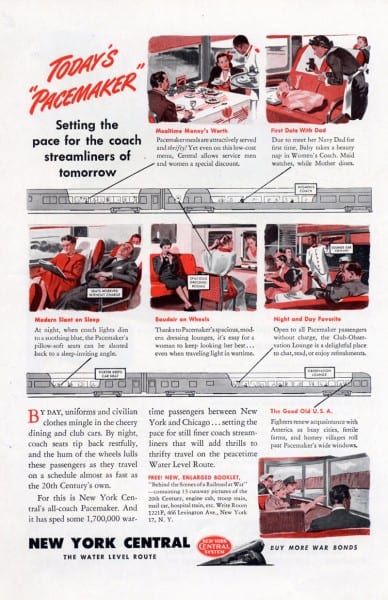
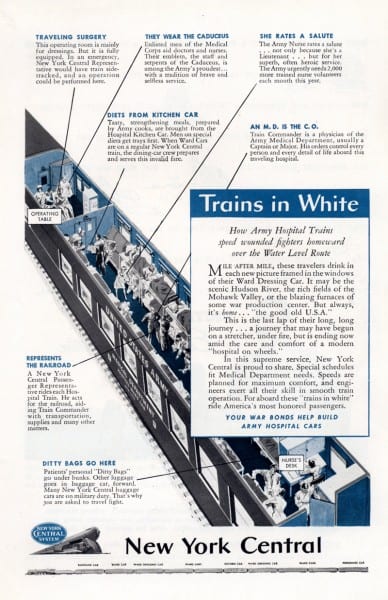
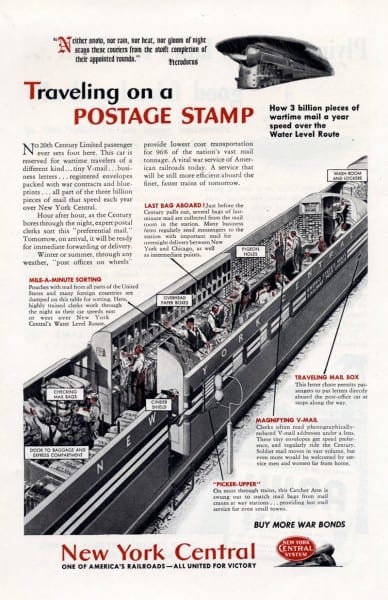
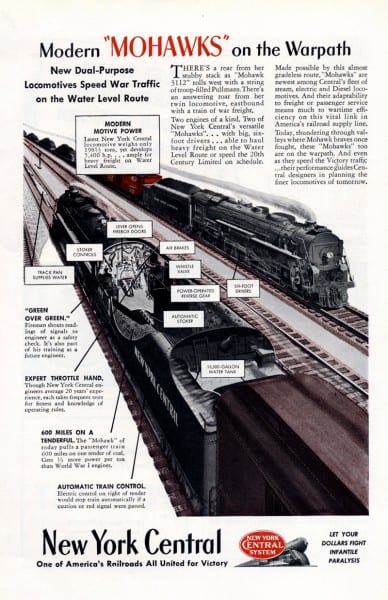
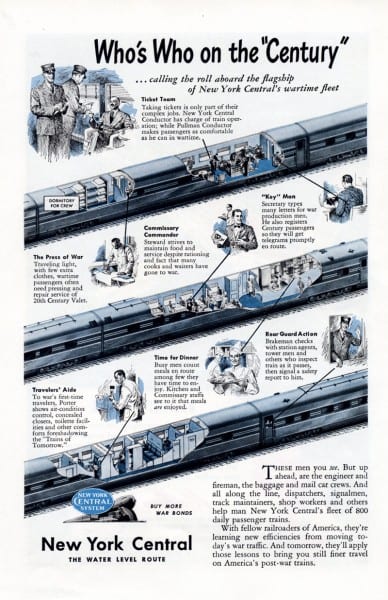
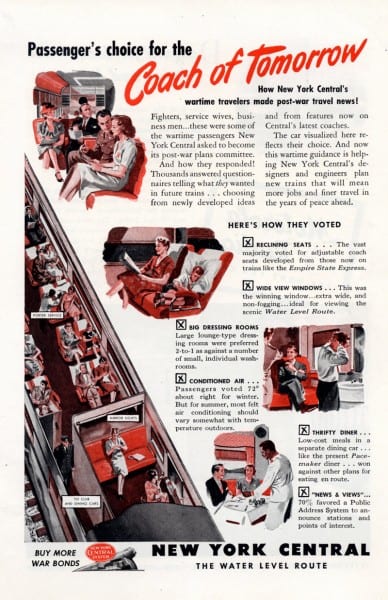
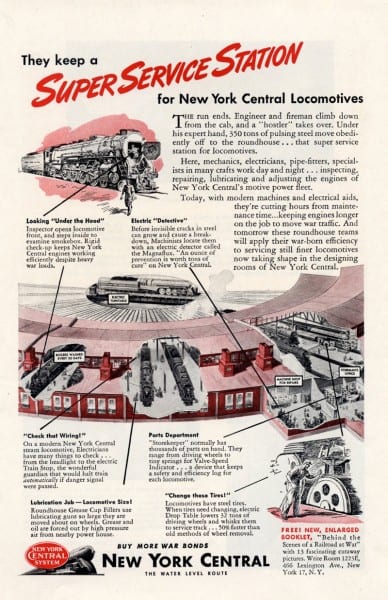
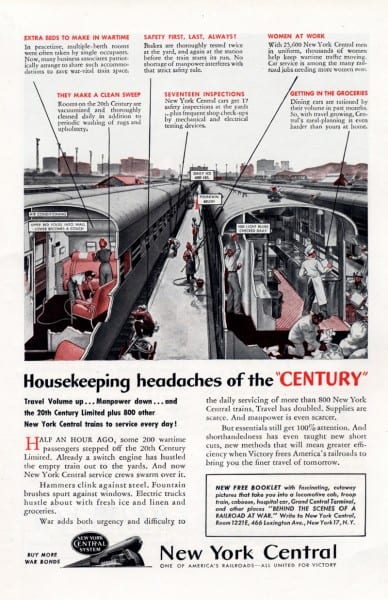
It is interesting to note that part of the reason why we have the Interstate System today can be attributed to the war. President Eisenhower pushed for the Interstate System, especially after experiencing the German autobahn while he served in World War II. He had also been associated with the Transcontinental Motor Convoy which drove from Washington DC to San Francisco, and took sixty-two days. That sort of puts it in perspective, how roads in between cities were back then. Today if you drove non-stop and managed to avoid traffic, you could drive that in two days. Sixty-two days, no wonder why people took the train!


Thanks for those great ads!
As for train vs. plane today, you also have to factor in travel time from center city (aka “downtown”) to the airport and security time at the airport. Let’s say that adds two hours on departure and another hour on arrival. For a flight from NY to FL that’s not much of a consideration. But for a flight from NY to Boston or DC it’s likely to be the better [sic] part of the trip. In other words, you’d spend more time getting to and from the plane than in the air. Which is why high-speed rail (really high speed, not just the Acela) might still happen in the northeast corridor. And maybe SF to LA.
FWIW, I grew up in the City in the 50s in a family that never had a car. Ever. Of course in NYC you don’t need one but, back then, it was possible to even go on vacation without one. We’d take the New York, New Haven and Hartford Railroad to Mom’s relatives in Western Mass or the Pennsylvania Railroad to Dad’s relatives in Pittsburgh. For all I know, we may have left from New York’s historic, and doomed, Penn Station.
Fast-forward several decades and one of my cousins was living in a apartment in Pittsburgh’s historic Penn Station. See http://www.thepennsylvanian.com/
Truth. MY WIFE and I are looking at a trip to Chicago later this year, and I was checking prices on AMTRAK because we both think it would be an interesting ride. Way too high.
Regarding train travel in the past, years ago, from roughly 1960 backward, trains were easier and more comfortable to ride than today. There were considerably many more towns served, and there was more of a network to allow easy interconnections between routes. Trunk routes had the choice of several trains a day to choose from. Most stations had an open ticket office and waiting room which made getting tickets and boarding the train easier. Coaches were generally more comfortable with bigger seats spaced further apart. Many trains had Pullman sleeping cars, dining cars with excellent food, as well as lounge cars with a bar. Major trains tended to be fast, for instance, the “Century” took only 16 hours between New York and Chicago, and even lesser express trains were still faster than today’s Lake Shore Ltd.
Principal stations en route had Pullman set-out and pick-up service. That is, say a train would arrive at an intermediate larger city at 2:00 a.m. A Pullman car for that city would be set out from the train onto a siding so the passengers could continue sleeping until morning. The opposite was provided, too. Say a train would depart a city at 3:00 a.m. Passengers could board the Pullman earlier, perhaps 9 pm, and the Pullman would be added to the train as it passed by. Obviously this required a critical mass of passengers to justify the expense, but in the past many intermediate-route cities had this convenience.
After WW II, the airlines began to operate bigger, more comfortable, and faster planes which business people flocked to to save time. Also, states began to improve local roads, build turnpikes and freeways, and build large airports. For example, the completion of the New York Thruway, New Jersey Turnpike, and Pennsylvania Turnpike, took away many passengers from the nearby Pennsylvania and New York Central railroads.
As passengers stopped riding the trains, railroads began to cut back on service, which made train travel less convenient. This further reduced patronage and led to a viscious download cycle.
Regarding riding Amtrak long distance trains today, it is a more civilized way to travel. The scenery is fascinating, be it farms or cities. A person can stay holed up in their compartment or mingle with other passengers in the lounge and dining cars; whatever they choose. There is a certain dignity about train travel that airlines just don’t have, especially today. (I do wish Amtrak was faster, cheaper, and available to more places.)
P.S. Thanks for posting the old advertisements. Neat stuff!